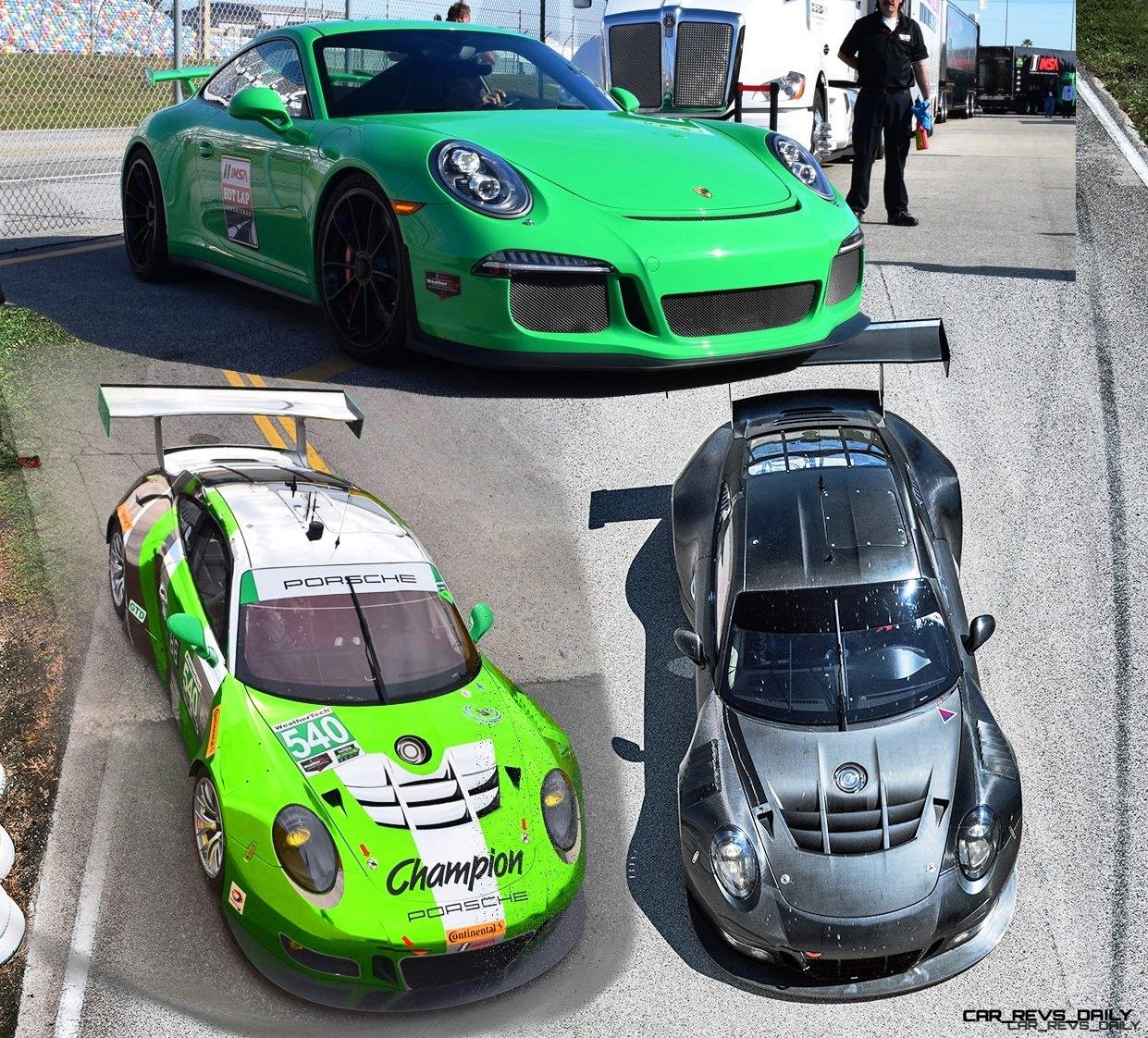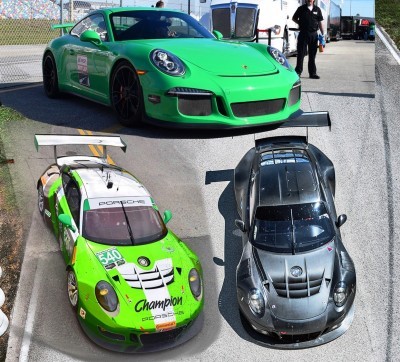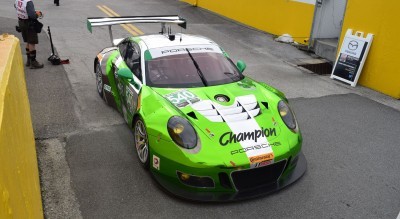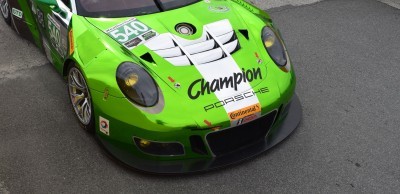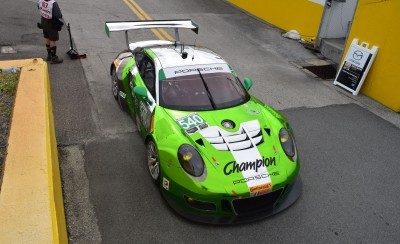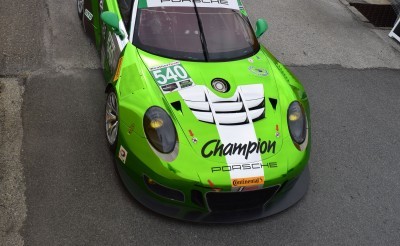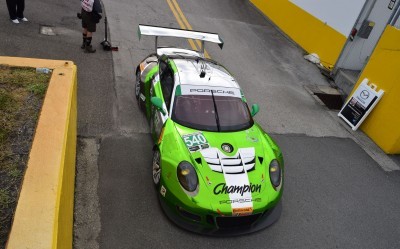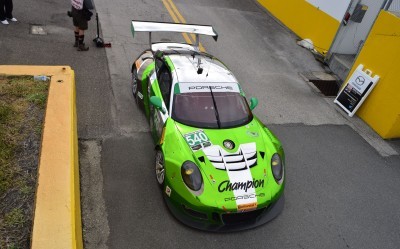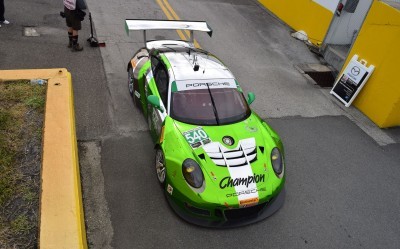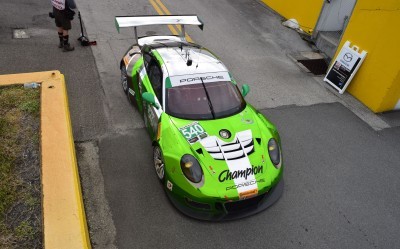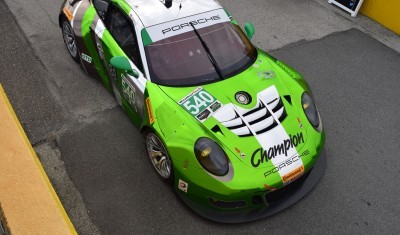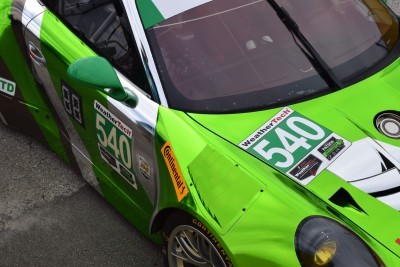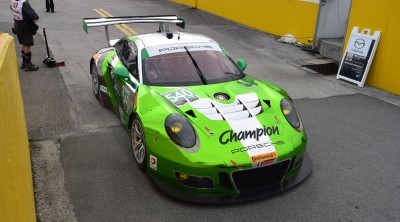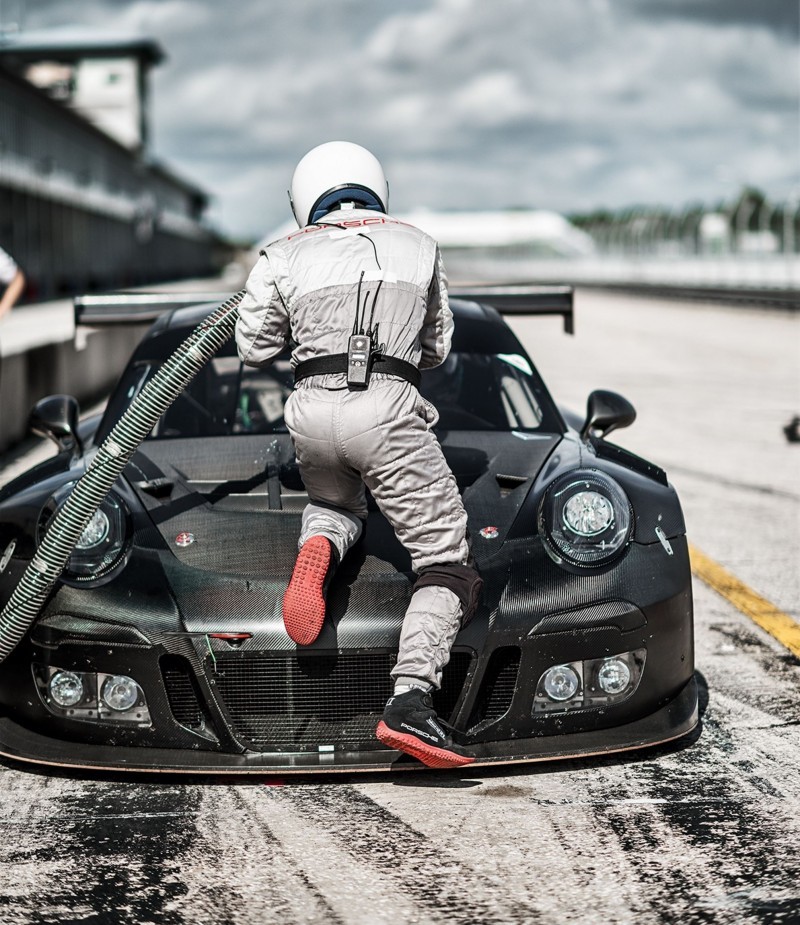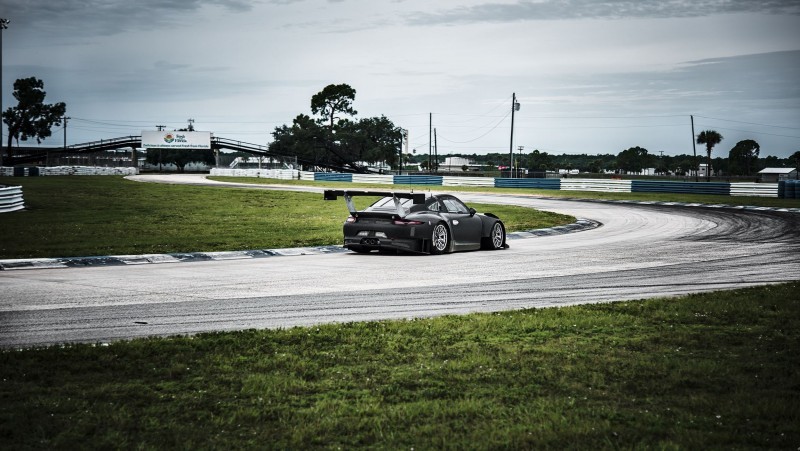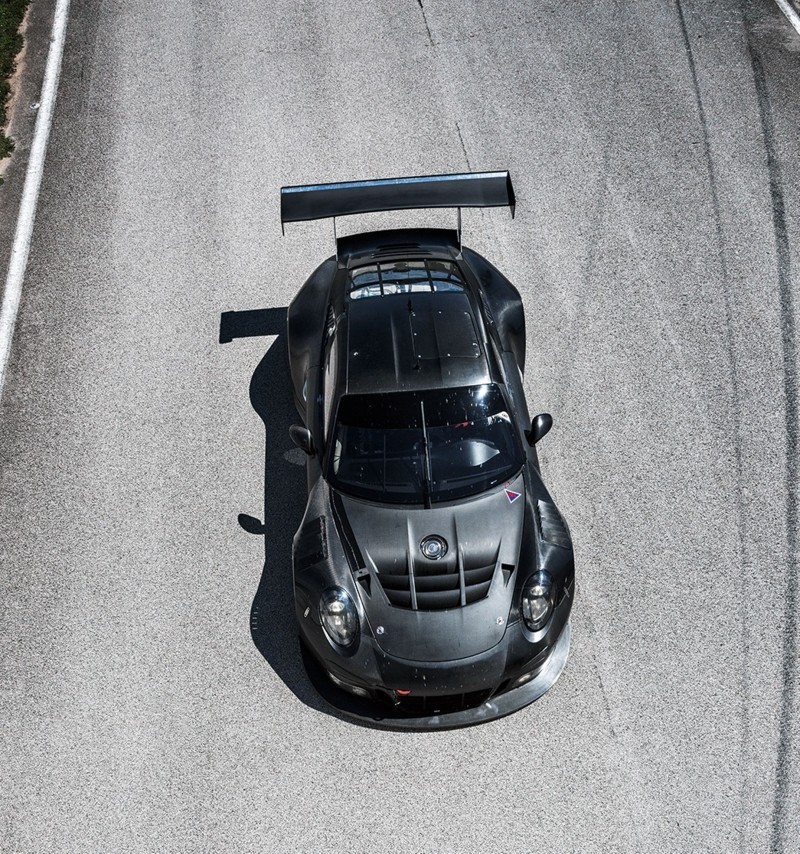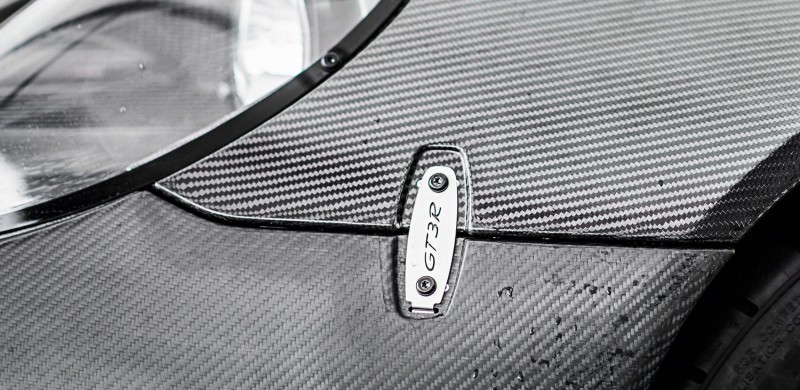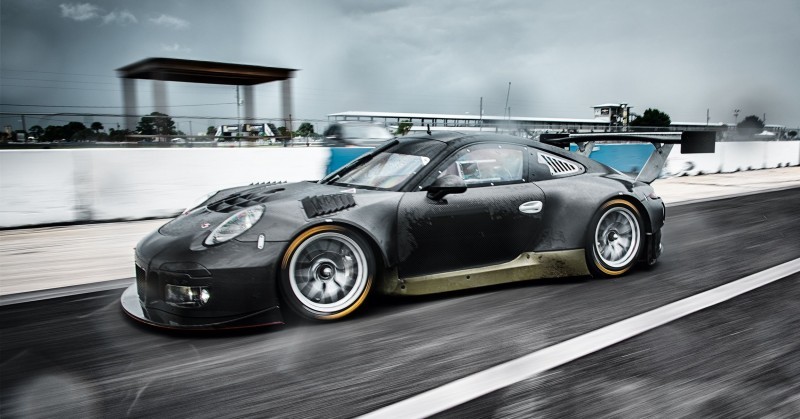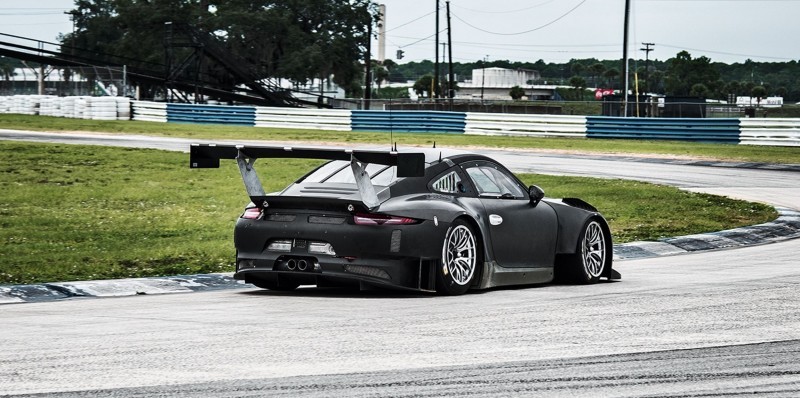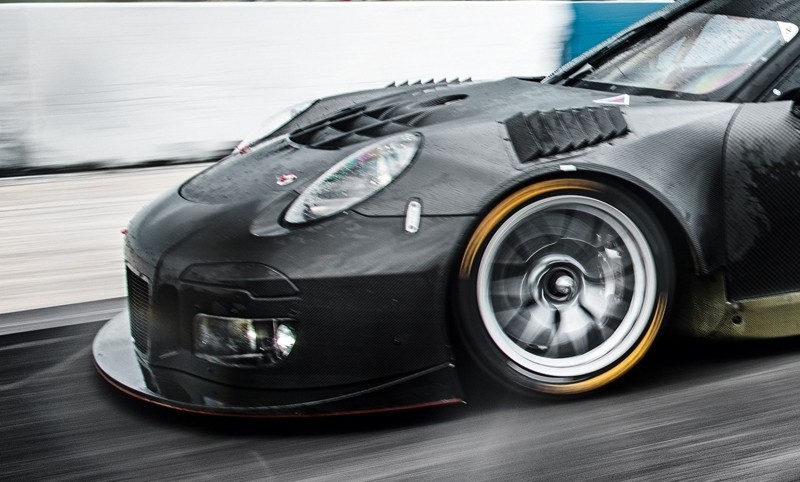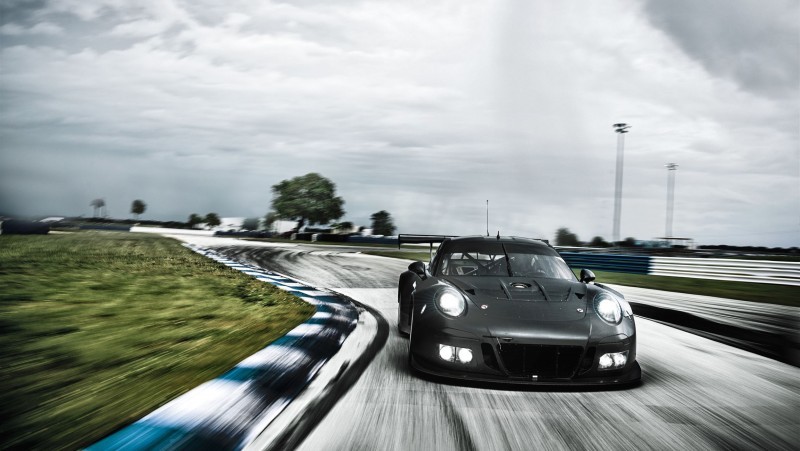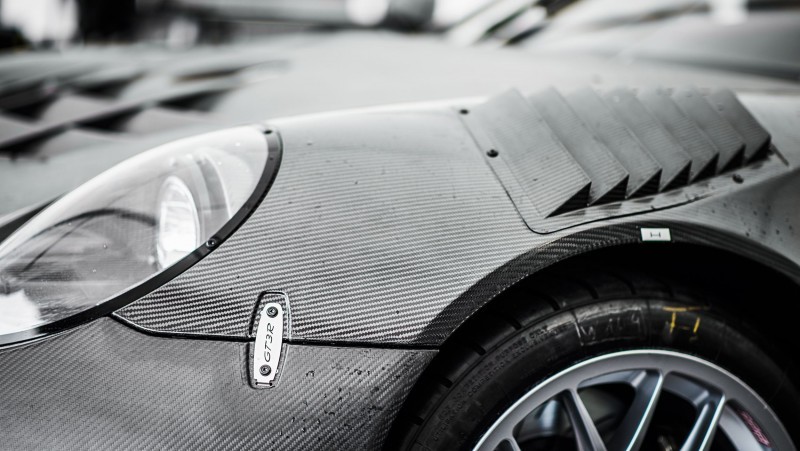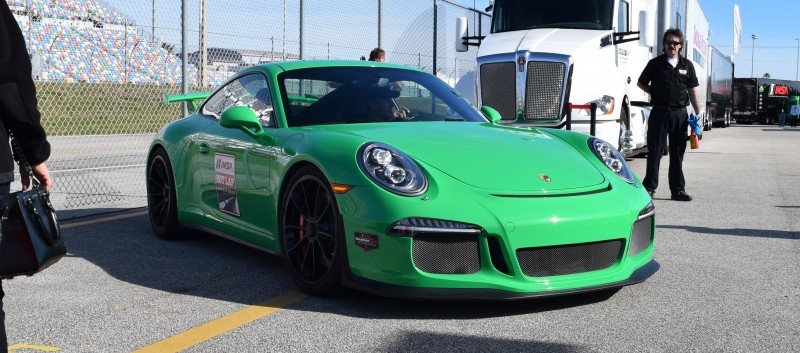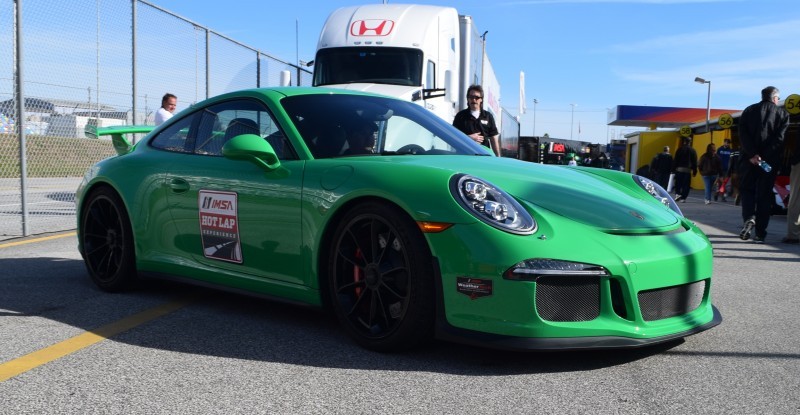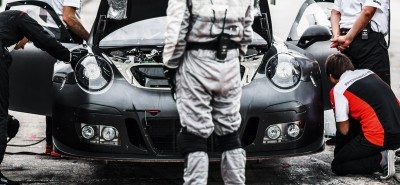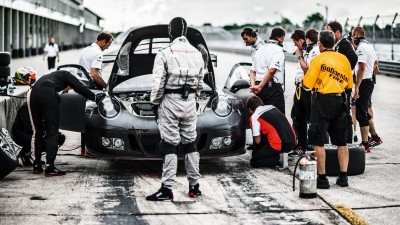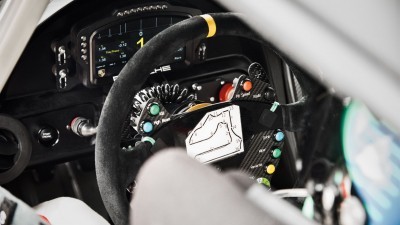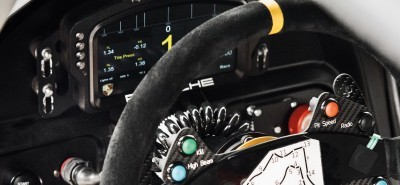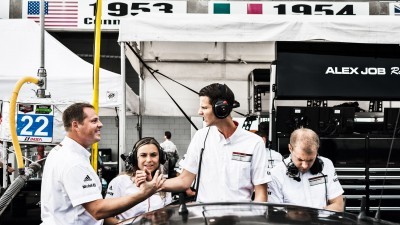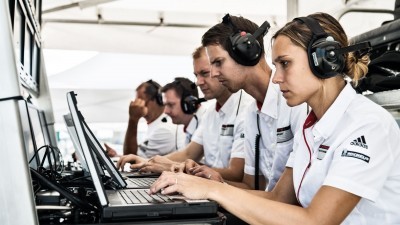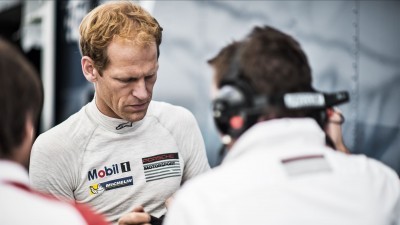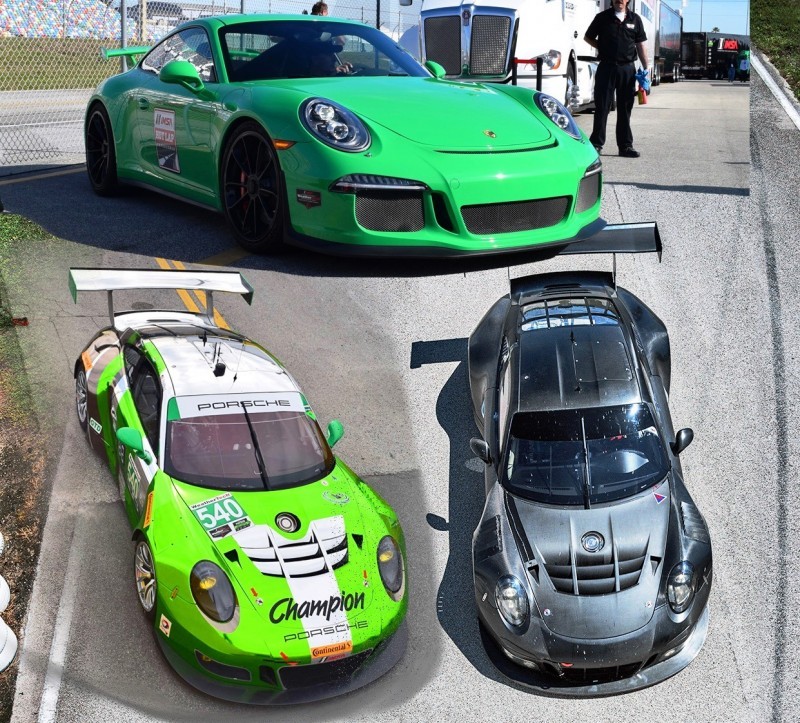 The official Porsche magazine Christophorus has a terrific piece in their latest issue about the shakedown testing of the heavily-revised 2016 Porsche 911 GT3 R around the hot, humid Sebring racetrack in Florida. Dubbed ‘Black Magic,’ the article follows the Porsche customer racing team through a marathon 30-hour race test late in calendar 2015 — ahead of the car’s entry into numerous race series worldwide in 2016.
The official Porsche magazine Christophorus has a terrific piece in their latest issue about the shakedown testing of the heavily-revised 2016 Porsche 911 GT3 R around the hot, humid Sebring racetrack in Florida. Dubbed ‘Black Magic,’ the article follows the Porsche customer racing team through a marathon 30-hour race test late in calendar 2015 — ahead of the car’s entry into numerous race series worldwide in 2016.
We’re excited to share the unpainted test car in its raw glory — but also some extra cool perspective on the 2016 GT3 R endurance racecar.
What is that? A few snaps of the latest GT3 street car at Daytona, plus a 20-pack of pics showing the new GT3 R as it was about to enter warmup laps for the 2016 Daytona 24-hour race last month.
In bright green chrome livery for Champion racing, we have a fairly rare high-res look at some of the new machine’s freshest elements: the aero package.
Up front, we see radical new fender vents with deep cuts into the front fenders. Newly deep hood aero slices are also visible in these photos, as are a pair of slim NACA intakes that appear a bit deeper than the 2015 GT3 R racer.
In truth, it is nearly impossible to visually distinguish the 2016 GT3 R from its 2015 predecessor — at least to our eyes. So much so… that now we are not sure this green dream is even a 2016, and not a continuation of the 2015 racer.
Are the the same, though?
Teraflops of data and hundreds of Porsche race analysts would beg to differ — and are working all-out to make the 2016 car a legendary race-winner!
Porsche 911 GT3 R – 2016 Daytona 24H – Quick Look
Christophorus Feature
Motorsports 02/11/2016
Black magic
The new 911 GT3 R race car goes to Sebring for a final shakedown. A 30-hour endurance test on the former airfield in Florida confirms the car is ready to go for the 2016 season.
The 911 GT3 R is dressed completely in black. Not because Porsche has an official dress code for its new customer GT race cars, but for very practical reasons. “All of the carbon-fiber parts start off black and aren’t painted until after the test phase,” project director Sascha Pilz explains.
This black beast descended on Sebring International Raceway toward the end of summer, accompanied by a number of support trucks. The 911 GT3 R has already survived multiple ordeals, including component tests and test drives on various European racetracks and a heat trial in Italy. Now, on this iconic raceway in central Florida, the car faces its final exam: a 30hour endurance run, split into three 10-hour segments due to safety regulations at the site. The testing team described their plans as follows: “During the endurance run we will only be returning to the pit to refuel, change the tires, and switch drivers.”
This makes perfect sense, as the new race car will be competing in several 24-hour contests over the 2016 season and the idea is for it to win.
Data, data, and even more data
At the moment, the 911 GT3 R is still reclining on a platform under a tent in the pit. Without its hood and wheels, it looks more like a test lab on wheels than a race car. The bicep-like bars of its roll cage are nearly obscured by a colorful mass of wires. What might look like a heap of confetti, however, is a carefully connected assemblage to an array of electronic control modules. After all, the 911 GT3 R is not only supposed to complete its 10-hour tests, but also generate data, data, and even more data on a constant basis. Even its transverse links have been furnished with strain gauges, to gather information on stress levels and the associated effects.
Situated in swampland about 130 kilometers south of Orlando, Sebring evokes a romantic and specifically American air of racing. Originally an army airfield, it was converted into a challenging raceway in the late 1940s. The front straight, which was one of the runways, used to be separated from the bleachers by bales of hay. The course has been changed a number of times since, but still retains its original flair. The hay, by the way, has been replaced by concrete barriers.
The surface and curves are especially hard on tires and brakes
The 12 Hours of Sebring has been one of the highlights of the racing season since 1952. And Porsche is the greatest name in its annals. Back in the early days, small 550 Spyders competed against gigantic front-engine roadsters from Cunningham, Maserati, and Ferrari. They set the tone for what would become a tradition: with 18 overall victories, sports cars from
Zuffenhausen are by far the most successful make at Sebring. The most recent victory came in 2008, with Timo Bernhard, Romain Dumas, and Emmanuel Collard at the wheel of an RS Spyder. So the 911 GT3 R could enjoy a home-field advantage, although the track remains as challenging as ever. Its combination of asphalt and concrete surfaces is considered especially rough on the suspension and brakes. And weather conditions in the late summer here about 60 kilometers from the Atlantic coast can bring their own cause for concern, such as a tornado or torrential downpour along with the subtropical heat.
2016 Porsche 911 GT3 R – Sebring Testing
Developing 368kW (500hp), the four-liter boxer engine of the 911 GT3 R is based on the current GT3 RS, i.e. on the fiercest naturally aspirated GT engine yet to be derived for the 911. The body shell starts off on the assembly line for roadgoing 911s at the plant in Stuttgart-Zuffenhausen, but is soon removed. After the roll cage is mounted, comprehensive finishing work is done by the motorsports department at the Weissach Development Center. The new powertrain with direct fuel injection is based on the 9A1 generation of the street-legal RS, and is also finished on the GT engine line in Zuffenhausen.
With the hefty addition of double-clutching when shifting down
New bearings for the forged crankshaft, new tuning for the intake camshaft, and an engine control unit designed for racing increase torque even further. The rev limiter doesn’t kick in until 9,500 rpm. The sequential six-speed gearbox, developed by Porsche and made by Ricardo, the English specialist in racing transmissions, is operated by toggle switches behind the steering wheel. The clutch, too, differs from that in the street-legal RS: it is made of carbon and plays only a cameo role. It is only used to move off at the start or after a pit stop. Too much time would be spent on engaging and disengaging it during gearchanges. The electronic engine system handles this faster and more efficiently, with the hefty addition of double-clutching when shifting down.
Despite heat convection and haze, the lines on the long start-finish straight on the former army airfield are sharp and clear. In its high-tech carbon-fiber outfit, the 911 GT3 R looks like an earthbound stealth bomber training for an extreme mission at zero altitude. Its unadorned carbon-fiber surface swallows all of its curves, edges, inlets, and arches. The only lines that remain form the silhouette of a Porsche 911 – clear, unambiguous, inimitable.
Quick-release fasteners connect the front sill to the wheel arches
Hovering above it all is the rear wing, an imposing aerodynamic element sitting at chest height or above. It appears to be even broader than the brutish looking wheel housings. A closer look, however, reveals the wing’s precisely designed shape, not unlike that of the street-legal RS.
The sound of the 911 GT3 R is every bit that of the gentleman racer. The exhaust system’s two tailpipes emit high-end tones in place of the unchecked volume of old. Clear and controlled, the GT3 R does not shriek at high engine speeds. At a distance all you hear is an audible but not overpowering race-bred boxer sound. When down-shifting at the end of the front straight, however, the engine throws off all its discretion. “Rrmm, rrmm, rrmm” – its unimitable soundtrack still fills the air long after the 911 GT3 R has disappeared around Turn One.
2015 Porsche 911 GT3 – Road Car
The temperatures in the cockpit approach those of a sauna
On the first day of the test, all of the systems are checked. The car leaves the pit, completes a single lap, and returns. Laptops are connected, data is downloaded, and the car goes out again. Of the six drivers scheduled for the week, Jörg Bergmeister and Wolf Henzler are taking turns. Each day’s data is sent to the Weissach Development Center that same night. One important finding: the temperatures in the cockpit approach those of a sauna.
The next day’s agenda calls for stints covering the range of a full tank of gas. Modern pit structures are viewed as a sign of weakness in Sebring, so all the action takes place out in the open along the pit wall. The performance and powertrain engineers check their laptops at a mobile bridge. To keep operating costs down, brakes in the GT3 class have conventional steel rotors instead of carbon-fiber composite versions. And the Tudor United SportsCar Championship (TUSC) allows just one type of Continental tire, so drivers and mechanics are taking the opportunity to become more familiar with it. Wolf Henzler, Jörg Bergmeister, and Bryan Sellers each drive for about half an hour before the “pit, pit, pit” command on the radio orders them back to the crew.
Pit stops during the 30-hour endurance test acquire a high-precision routine
The sequence of events during the pit stops acquires a nearly casual routine: braking right before the lollipop, jacking up the car, changing the tires, refueling, switching drivers. The brake technicians check the temperature of the rotors while the mechanics examine the wear on the tires. One mechanic wearing a helmet and fire-resistant overalls climbs onto the hood to insert the hose into the tank for rapid refueling. A new driver, the same car. Although the telemetric systems record every piece of data the 911 GT3 R transmits, some crew members automatically press their stopwatches. That comes from a long tradition. What makes test drives so valuable is not just the data recorded by the mechanical systems, but also the insights and impressions gained by the crew.
The drivers report a few irregularities under braking at the end of the front straight. Discovering this type of thing is precisely the reason why tests are held under extreme conditions in Sebring. The raceway is a challenge to both the materials and the calibration. But although brake performance declines – ever later pressure points, delayed response – the lap times remain consistent. Sellers, Henzler, and Bergmeister use their talent to compensate, and provide detailed analyses when back in the pit. American driver Bryan Sellers, who will be paired with German driver Wolf Henzler in the TUSC GT series, concludes his monologue about the brakes with a grin and says “tell me if I’m talking too much.”
The 911 GT3 R will be able to compete as a customer race car in all 2016 series that follow FIA regulations as well as the TUSC. That includes the popular and very challenging 24-hour races in Daytona, Spa-Francorchamps, Dubai, and on the Nürburgring. Only the add-on parts will keep the carbon look, however, because the car bodies will be delivered in white.
Info
Text first published in the Porsche customer magazine Christophorus, No. 374
By Eckhard Eybl // Photos by Victor Jon Goico
Link to this article
More articles https://goo.gl/R2SJdr https://goo.gl/MkDixM https://goo.gl/YUBjWV
External Links
http://www.porsche.com/uk/aboutporsche/christophorusmagazine/

Tom Burkart is the founder and managing editor of Car-Revs-Daily.com, an innovative and rapidly-expanding automotive news magazine.
He holds a Journalism JBA degree from the University of Wisconsin – Madison. Tom currently resides in Charleston, South Carolina with his two amazing dogs, Drake and Tank.
Mr. Burkart is available for all questions and concerns by email Tom(at)car-revs-daily.com.

